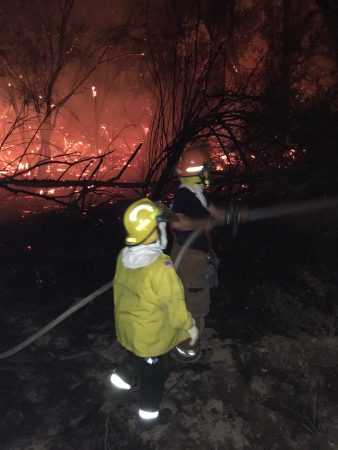
Roach Fire. Donna Woods property in Dudleyville. Photo by Rene Pacheco
Visitors to Coronado National Forest are advised to use extra caution while outdoors due to the onset of monsoon season and the increased potential for thunderstorms, strong winds, lightning, heavy rain and flooding.
While a very welcome event, monsoon season brings with it lightning that has historically ignited a number of wildfires across the Forest’s landscapes. Lightning-ignited wildfires are expected to occur over the next several weeks as monsoonal moisture moves into the area. While some fires will be immediately evident, others may remain undetected for several days until conditions become favorable for them to grow into observable incidents.
Wildland firefighters are positioned to respond to the expected new ignitions as the monsoon begins. It is anticipated that normally-occurring wetting rains will be associated with many of the lightning events and sufficient rain will fall to reduce wildfire activity and pause the Coronado’s year-round fire season. Until then and beyond, fire crews remain vigilant to respond to new ignitions.
Precipitation moves into southeastern Arizona sporadically. Rain may fall on some areas of the Forest, leaving other areas dry. Significant, wetting rains are needed to overcome dry conditions prevalent across the Coronado. For this reason, Stage 2 fire restrictions remain in effect throughout the Forest.
Until fire restrictions are rescinded, the following are prohibited:
• Building, maintaining, attending, or using a fire, campfire, charcoal, coal, or wood stove fire, including within a developed recreation site, or improved site.
• Using an explosive.
• Smoking, except within an enclosed vehicle or building. (Smoking is prohibited in all federal buildings.)
• Operating or using any equipment powered by an internal combustion engine, except motor vehicles.
• Welding, or operating acetylene or other torch with open flame.
• Discharging a firearm, air rifle or gas gun, except while engaged in a lawful hunt pursuant to state, federal, or tribal law, and regulations.
• Possessing or operating motor vehicles off National Forest System roads, including but not limited to cars, trucks, SUVs, motorcycles, and ATVs, except for when parking in an area devoid of vegetation within 10 feet of the roadway, and except for parking overnight in Forest Service developed campground and trailheads.
Fireworks are always prohibited year-round on federal lands.
Thunderstorms may develop quickly and without warning. Heavy rainfall may cause flooding of roads, streams, trails and canyons during and after storms, especially in areas that have recently burned. In mountainous areas with limited access, road closures and delays are possible if roads become compromised by erosion, rock slides or debris flows. Motorists are encouraged to carry extra food, water, flashlights and warm clothing, and to be prepared for temporary delays which could last hours for road-clearing.
Recreationists are advised to check weather forecasts for areas they plan to visit and plan accordingly. Thunderstorms can develop quickly and may bring heavy rain, hail, lightning, strong winds and cooler temperatures. Flooding downstream from storm cells is common.
Tips for lightning and flooding safety:
• Postponing activities when storms are in the forecast may prevent being caught in a dangerous situation.
• When outdoors, monitor the weather and watch for signs of thunderstorms.
• Develop a lightning safety plan by knowing where to go for safety and the amount of time needed to get there.
• If thunder can be heard, lightning may strike. Seek shelter in an enclosed building or hard-topped vehicle. Avoid open areas and trees.
• Rain falling high in the mountains will drain downhill, and may cause flash flooding below areas where rain is falling. Avoid low-lying areas, streams and slot canyons during and after storms.
If flooding occurs, seek safety on higher ground.
Planning ahead and using situational awareness is recommended to prevent monsoon storm-related emergencies.
